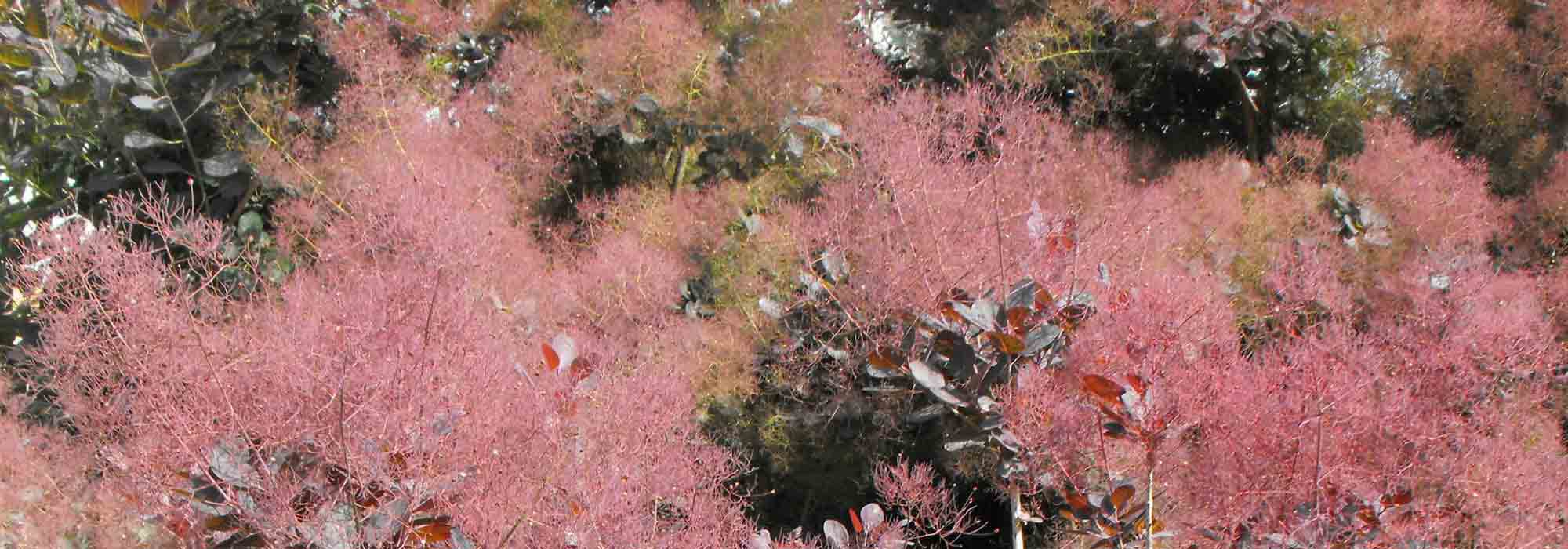
Cotinus, smoke tree: planting, pruning and care
Contents
Cotinus in a nutshell
- The cotinus or smoke tree offers a dazzling feathery flowering
- Easy to grow, tolerant of lime, it adapts to almost all soils
- Its foliage displays sumptuous autumn colours
- It is vigorous and hardy down to -20°C
- It brightens up hedges, borders, and even terraces
A word from our expert
The Cotinus, notably the Cotinus coggygria and its American cousin the Cotinus obovatus, nicknamed “smoke trees”, are large bushy shrubs with deciduous foliage that is green or purple, turning into sumptuous colours in autumn, and whose inflorescences provide a spectacular feathery appearance reminiscent of a wig in summer.
With deep purple foliage like that of the famous Cotinus ‘Royal Purple’, intense red in the cultivar ‘Grace’, or golden yellow in the Cotinus ‘Golden Spirit’, all enchant in summer and autumn. Over the seasons, the leaves beautifully change from yellow to orange, then to garnet red or purple as winter approaches.
Of Mediterranean origin, the smoke tree is resistant to cold and especially well to heat. Easy to cultivate, planted in full sun or partial shade, this undemanding shrub adapts to all types of soil (well-drained), even calcareous and stony ones.
A shrub of medium growth, the Cotinus is a plant of good stature perfect for bringing colour to the garden throughout the seasons and brightening up free hedges, persistent shrub borders, and sunny rockeries. Some dwarf varieties are now suitable for small spaces as well as for container cultivation.
Discover in our collection this hardy and rustic shrub that offers a fiery and surprising brilliance to all natural gardens.
Description and Botany
Botanical data
- Latin name Cotinus, Cotinus Coggygria
- Family Anacardiaceae
- Common name Smoke tree, Fustet, Smoke tree
- Flowering from May to September
- Height 1 to 10 m
- Sun exposure Sun, partial shade
- Soil type All, well-drained
- Hardiness -20°
Le Cotinus, commonly known as “smoke tree” or also “Fustet” or “Jupiter’s beard”, belongs to the large family of Anacardiaceae. The genus consists of only two species of trees and bushes with deciduous foliage, the Cotinus coggygria native to Eurasia, which is the most well-known, and its American cousin, the Cotinus obovatus from North America. They grow naturally in rocky areas and under dry climates. They are available in about ten cultivars, plus a few hybrids.
In our country, this bush, most often shrubby, grows easily in gardens all over France. It grows spontaneously on dry, poor, and calcareous slopes, even arid ones in the South-East, from the Alpes-Maritimes to Ain, Ardèche, Gard, and Aveyron. It withstands drought, wind, and urban pollution well.
The Cotinus coggygria forms a bushy shrub with a dense, irregular habit, with knotted and divergent branches, more or less erect, averaging 3 to 6 m high and almost as wide. The Cotinus obovatus is the largest and can reach 10 m in height and 8 m in spread. It has a dense, globose, and broader habit. The cotinus can, when not pruned, expand and develop a dome-like shape that can become quite imposing. The ramified trunk has bark that is initially smooth but becomes rough and cracked with age.
There are also dwarf varieties such as Cotinus coggygria ‘Lilla’ and Cotinus ‘Young Lady®’ with a very compact habit that will reach a maximum height of 1.2 to 1.5 m and 1 m in spread at maturity.
With the Cotinus, the foliage offers a true spectacle throughout the year. This somewhat anarchic vegetation is distinguished by its exceptional autumn coloration. The deciduous leaves appear as early as April, are oval-rounded in shape, and measure 5 to 15 cm long depending on the varieties. They are arranged alternately on the branches and in rosettes of leaves at the tips of the branches.
Some develop a purple-tinged foliage that can be intense, like that of coggygria ‘Royal Purple’, while others have apple green or golden yellow foliage like Cotinus coggygria ‘Golden Spirit’. Their hues change with the seasons, some lightening in summer. All take on warm shades in autumn, around October, ranging from orange-red with coppery reflections to lemon yellow, vermilion orange, scarlet red, reddish-purple, and violet.
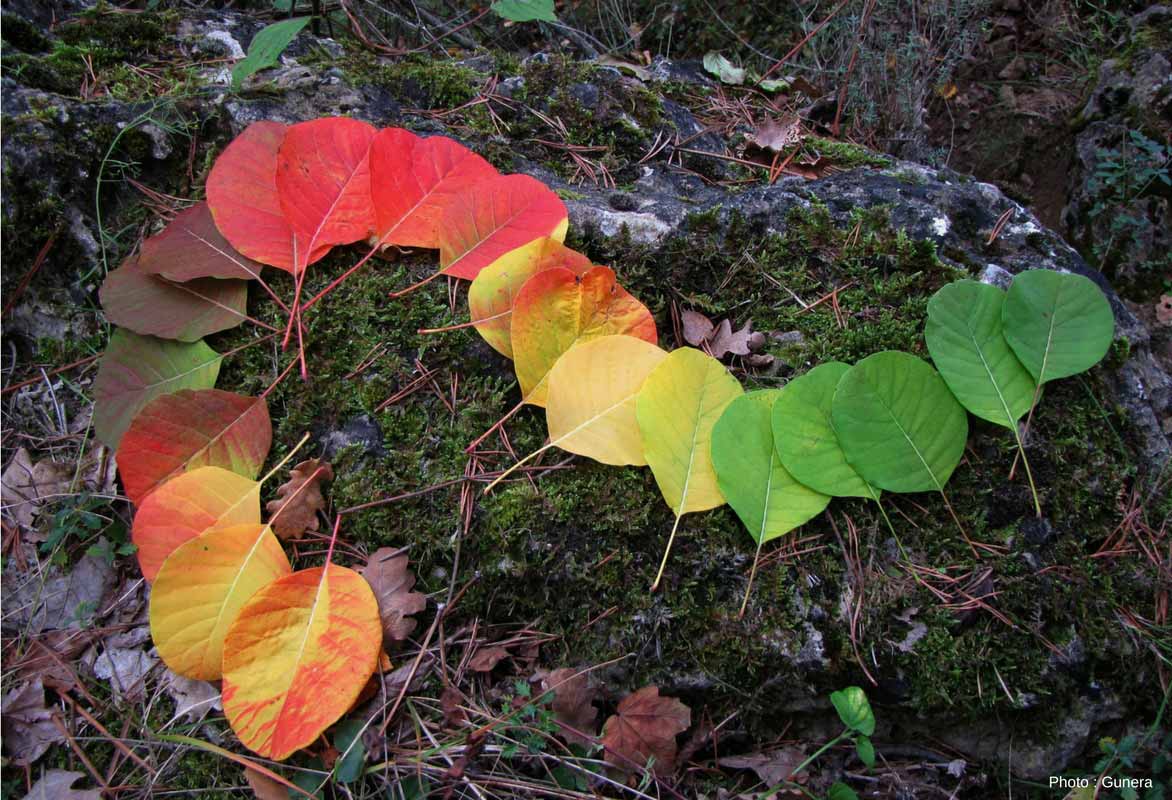
The wide palette of colours that the cotinus can take on in autumn
The young shoots and leaves, when crushed, release a characteristic turpentine scent.
Spectacular as well as surprising, the flowering composed of a multitude of feathery pedicels envelops the foliage of the Cotinus with graceful plumes from summer to autumn. In May-June, numerous small greenish or yellowish flowers appear grouped in airy terminal panicles. The pedicels of the sterile flowers then elongate into long filaments, forming a vaporous and feathery hair in white, tea rose, or purplish pink, and more rarely coppery orange (‘Golden Spirit’) with a beard-like appearance but especially resembling a wig, which gives the cotinus its nickname “smoke tree”. Across the Channel, it is known as “smoke tree” or “smoke tree”, these cotton-like inflorescences evoking more to the English clouds of smoke than feathers.
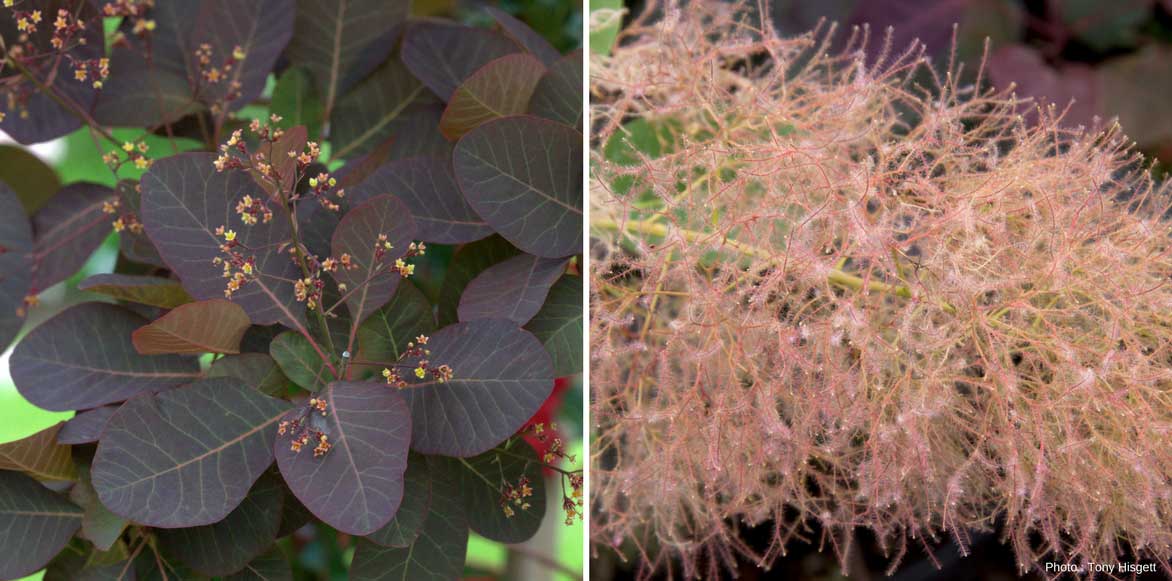
The flowering of the Cotinus or smoke tree
Melliferous, these plumes attract bees. The feathery branches of the Cotinus can be used to create lovely fresh bouquets in summer or dried in winter. In September, small brown, shiny, and wrinkled fruits appear scattered on the feathery infructescence.
Easy to cultivate, very hardy down to -20°C and tolerating heat well, like its cousin the Virginia Sumac, the Cotinus is a shrub that loves well-drained, poor, and light soils. It adapts very well to all soils, even calcareous and stony ones. Once established, it tolerates drought but fears excessive moisture in winter, especially in heavy and clayey soils. While it tolerates partial shade, it prefers full sun where its reddish-purple leaves offer a fiery glow at the slightest ray.
With its bushy, somewhat anarchic habit, the Cotinus is a must-have for informal gardens and those with a naturalistic spirit. It easily finds its place in free hedges, rockeries, or in groups of evergreen shrubs or even in a large pot on a terrace. Its small size is interesting for small gardens.
The sap of the smoke tree flowing from the branches is very irritating to the skin. Its wood was once used by luthiers and cabinetmakers.
Species and main varieties
The smoke tree generally does not exceed six metres in height, except for the species c. obovatus which reaches up to 10 m. In recent years, more compact dwarf varieties such as ‘Young Lady’ have emerged, perfect for small spaces and container cultivation.
The most common species in our gardens is Cotinus coggygria, which is available in about ten cultivars, including the famous Cotinus ‘Royal Purple’. Some have purple foliage, while others have green or golden-yellow foliage. The branches of the purple-leaved varieties are slightly less feathery, but their foliage is particularly ornamental.
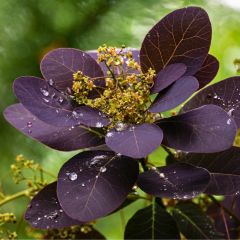
Cotinus coggygria Royal Purple - Smoke Bush
- Flowering time July to September
- Height at maturity 3,50 m
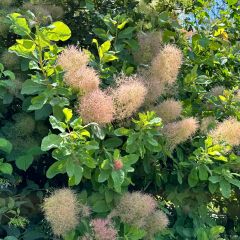
Cotinus coggygria - Smoke Bush
- Flowering time June to September
- Height at maturity 3 m
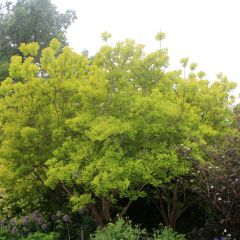
Cotinus coggygria Golden Spirit - Smoke Bush
- Flowering time June to September
- Height at maturity 3 m
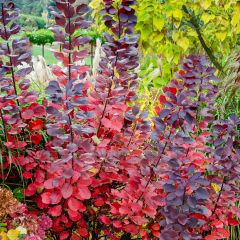
Cotinus Grace - Smoke Bush
- Flowering time August, September
- Height at maturity 5 m
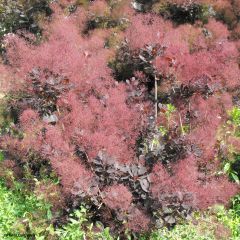
Cotinus coggygria Lilla - Smoke Bush
- Flowering time July to September
- Height at maturity 1 m
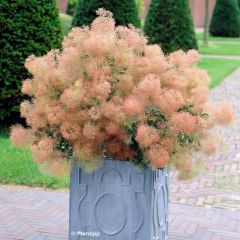
Cotinus coggygria Young Lady - Smoke Bush
- Flowering time July to September
- Height at maturity 1,20 m
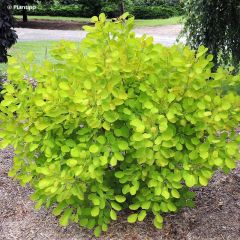
Cotinus coggygria Golden Lady - Smoke Bush
- Flowering time July to September
- Height at maturity 2 m
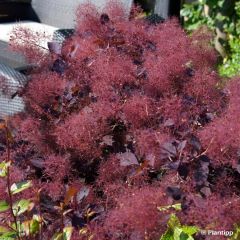
Cotinus coggygria Dusky Maiden - Smoke Bush
- Flowering time July to September
- Height at maturity 2,50 m
Discover other Cotinus - Smokebush
View all →Available in 0 sizes
Available in 5 sizes
Available in 2 sizes
Available in 1 sizes
Available in 3 sizes
Available in 1 sizes
Available in 2 sizes
Available in 1 sizes
Available in 1 sizes
Available in 2 sizes
Young plantation
Where to Plant the Smoke Tree?
If the smoke tree enjoys the dry climates of our arid hills in the South-East, it settles well throughout France. It is capable of withstanding very low temperatures of -20 °C, ensuring perfect hardiness in all regions.
It is a frugal bush, easy to grow in well-draining, poor, and light soil, even very calcareous. It hates heavy, compact, and clayey soils, especially waterlogged in winter. Once well established, it withstands drought, heat, wind, and urban air pollution quite well.
In terms of exposure, it prefers full sun which enhances its purple or golden foliage but can tolerate light partial shade where it will be less vibrant.
Versatile, this bush can be planted alone for a spectacular effect in summer and autumn or in a free hedge with other decorative shrubs like forsythia, lilac, and cotoneaster, in a mass of evergreen shrubs. It is useful for dressing a large, unattractive slope that other shrubs would not accept, alongside large grasses or buddleias.
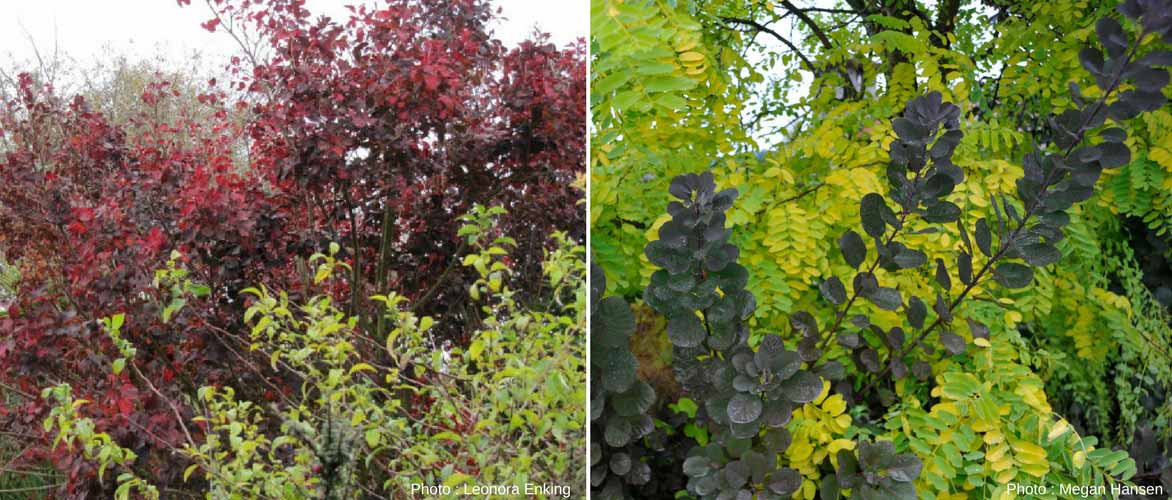
The cotinus (here, ‘Royal Purple’) is perfect in a free hedge
The smaller varieties are well-suited for dry rockeries with nepeta, stachys, lavenders, and rosemaries and can be grown in pots on the terrace or balcony.
When to Plant the Smoke Tree
Plant the Cotinus preferably in spring in February-March or in autumn from September to November.
How to Plant the Cotinus?
The smoke tree enjoys well-draining soils where water will not stagnate. In a hedge, space the plants 1 m apart.
In the ground
- Loosen the soil well and dig a hole 3 to 5 times wider than the root ball
- Add a good layer of pumice or gravel at the bottom of the hole
- Plant the bush without burying the collar
- Fill the hole while keeping the bush upright and compact with your foot
- Water generously at planting and then regularly during the first summers
In a pot
Some dwarf varieties of smoke trees are interesting to grow in pots, such as Cotinus coggygria ‘Lilla’. The substrate must be very well-draining to avoid stagnant moisture.
- At the bottom of a container at least 50 cm in diameter, spread a good layer of drainage (broken pottery, gravel, or clay balls)
- Plant in good, slightly sandy potting soil
Pruning and care
Cotinus requires no special maintenance, as it is a bush that is resistant to both cold and heat. Pruning is not obligatory, but it is recommended to maintain a harmonious, bushy habit and a lush foliage. As it ages, it tends to become sparse.
In February-March, before the resumption of growth, carry out a fairly severe pruning by removing diseased or dead wood, the tips of the shoots that have been damaged by frost, and the tangled branches to retain only the vigorous branches. Cut back the stems by half to maintain a compact habit and to thicken the branches. The idea is to slightly reduce the branches and bring some transparency to your bush.
The smoke tree tolerates being cut back well: after a few years, do not hesitate to cut it back to the ground: at the end of winter, cut the stems back to 2 or 3 buds from the base.
Diseases and potential pests
The smoke tree is not very susceptible to diseases or attacks from parasitic organisms. The only major enemy of Cotinus is moisture. In spring, it can fall victim to verticillium wilt, a fungal disease caused by excess moisture, which can lead to its decline: the leaves turn yellow and undergo necrosis. There is no curative treatment; spray a decoction of horsetail or garlic preventively from spring. In case of an attack, remove the contaminated parts.
Propagation
The smoke tree can be propagated by sowing, layering in March, and propagation by cuttings in June. We do not recommend sowing, as it is too lengthy and difficult to succeed.
By herbaceous cuttings
- In May-June, take healthy stem tips of 10 to 15 cm just below an eye, ensuring to keep at least 3 eyes
- Remove the lower leaves and retain only two pairs of upper leaves
- Plant them in a well-draining, light mix of sand and potting soil
- Cover (with cling film, for example) and place in a humid, warm environment
- Keep the substrate moist until rooting, which takes 1 to 3 months
- Transplant your cuttings into the ground in autumn and water well during the first year
By layering
- In March, dig a furrow 5-10 cm deep in the soil near the parent plant. Choose a flexible stem at the base of the bush that is easy to bend to the ground
- Remove the leaves from this part of the stem
- Lay it down, angling it towards the ground, burying part of it for rooting
- Fill in the furrow and secure the layer (you can use camping pegs or metal hooks)
- Raise the end and stake the aerial part
- You can separate the layer from the parent plant in autumn when it has enough roots and replant it in the ground at your chosen location
Associating
Cotinus is an ornamental bush in summer as well as in autumn to be grown alone or in combination. When planted alone, it introduces an original focal point in the garden under which a carpet of heucheras and Hakonechloa can be planted, as seen in this setting:
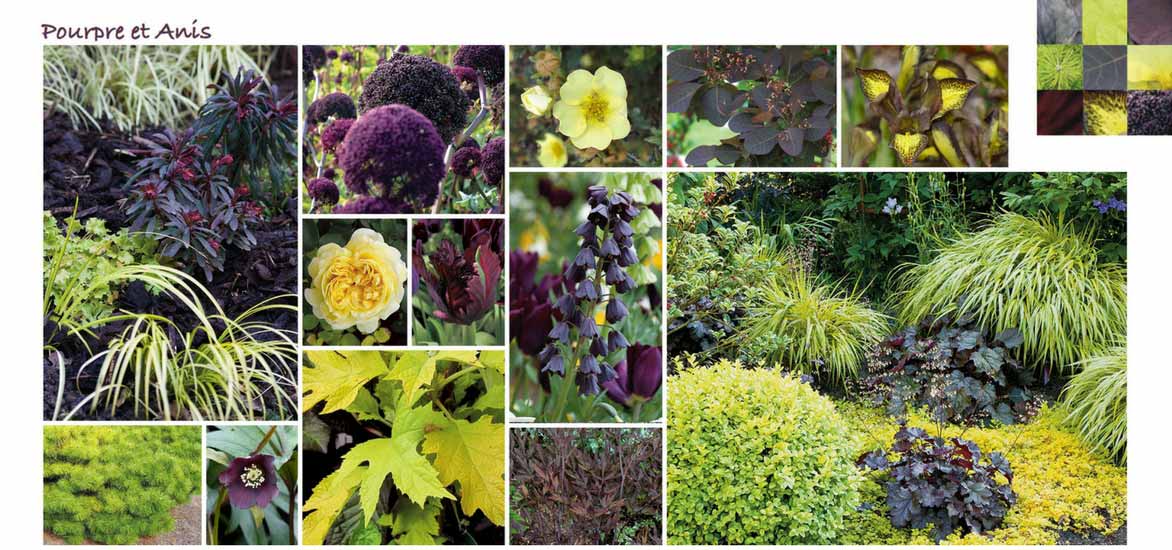 Purple and anise inspiration, to be found in detail by clicking on the image…
Purple and anise inspiration, to be found in detail by clicking on the image…
It forms lovely backgrounds for flower beds that stand out against a dark backdrop of evergreen foliage such as boxwood, escallonias, thujas, or laurustinus.
In a free hedge, it will be the perfect companion to other decorative bushes such as forsythia and lilac, cotoneasters. Varieties with purple foliage create interesting contrasts alongside plants or bushes with grey foliage (wormwoods, Buddleia ‘Silver Anniversary’), blue (Eucalyptus gunii), yellow (Sambucus nigra ‘Golden Tower’) or even the variegated foliage of the shrimp willow.
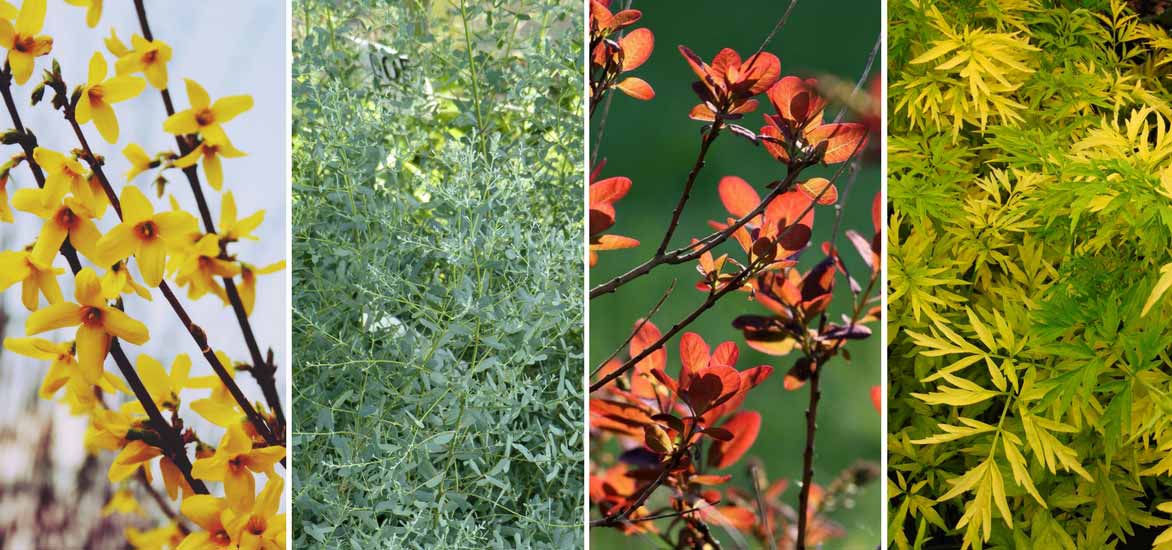 Forsythia, Eucalyptus gunnii ‘France Bleu’, Cotinus ‘Royal Purple’ and Sambucus nigra ‘Golden Tower’
Forsythia, Eucalyptus gunnii ‘France Bleu’, Cotinus ‘Royal Purple’ and Sambucus nigra ‘Golden Tower’
It will make a statement when dressing a large slope alongside tall grasses (Panicum virgatum, Stipa gigantea…)
In a dry rockery, it finds its place alongside nepetas, stachys, dianthus, lavenders, monardas, thymes, rosemaries or dwarf buddleias.
Cotinus can be used as a support for perennials such as a vigorous geranium oxonianum ‘Claridge Druce’ or annual climbers like morning glories, perennial peas. It can also host a clematis or a Lonicera that can weave among its branches to create a charming tapestry of foliage and flowers.
Small varieties like ‘Lilla’ or ‘Young Lady’ can be grown in pots on a terrace or balcony in the sun, surrounded by blue flowers (Agastache ‘Blue Fortune’, Ceratostigma griffithii), or pinks (Salvia microphylla grahamii, Alcea, sedum…).
 At The High Line in New York, Cotinus ‘Grace’, paired with grey birch (betula populifolia ‘Whitespire’) is a true star!
At The High Line in New York, Cotinus ‘Grace’, paired with grey birch (betula populifolia ‘Whitespire’) is a true star!
Useful resources
- Discover our wide range of Cotinus or Smoke Tree
- Francis Peeters talks to us about Cotinus ‘Grace’ and Cotinus ‘Young Lady’ as part of the “Gardens and Leisure” programme on RTBF
- Discover our advice sheet Purple Cotinus: the most beautiful varieties
- Subscribe!
- Contents




































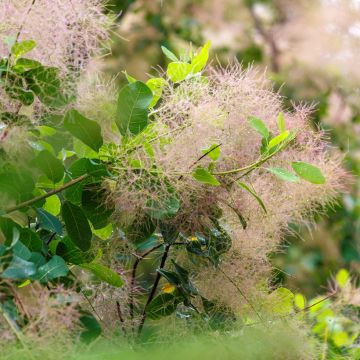

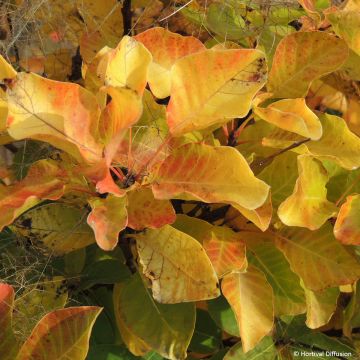


Comments